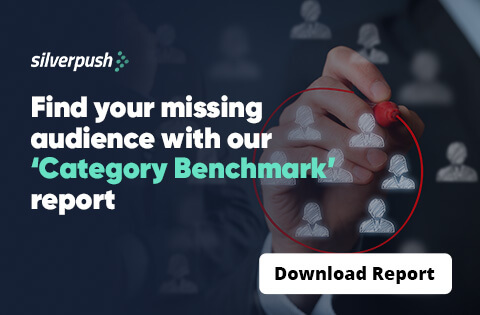Trick or Treat? Reach Your Audience with Spooktacular Ad Campaigns!
PUBLISH DATE: 10 October 2023
“A successful marketing campaign is like a well-carved pumpkin – it leaves a lasting impression.”
Every brand and advertiser aims to craft a compelling narrative that deeply connects with their audience, and leaves a lasting impression. Halloween season offers a unique opportunity to connect with your audience through spooktacular Halloween ad campaigns that capture the spirit of the holiday.
But before we delve into how to seize the opportunity let’s focus on….
Why Advertisers Should Ace Their Halloween Campaigns?
Halloween isn’t confined to any particular region anymore. It’s a global celebration, making it the perfect stage for brands to embrace cross-cultural marketing or launch multicultural campaigns. Did you know, in Japan, approximately 20-30 million people celebrate Halloween each year whereas, in the Philippines, 90% of people know and celebrate the spooky festival.
Moreover, Halloween spending is on a thrilling trajectory, set to hit a spine-tingling $12.2 billion this year, surpassing the 2022 figures by $1.6 billion.
Where the audience is spending the most?
The big bucks are flowing into candy (96%), decorations (77%), costumes (69%), and even greeting cards (35%). And where are folks flocking to get their Halloween fix?
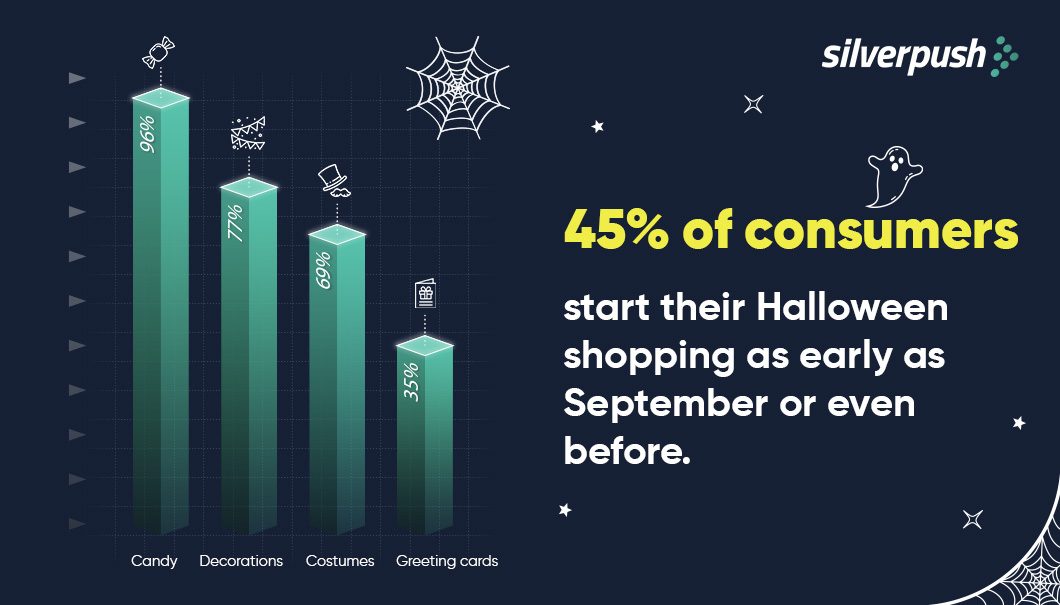 Candy (96%), Decorations (77%), Costumes (69%), and even Greeting cards (35%). 45% of consumers start their Halloween shopping as early as September or even before. Additionally, a significant 22% of consumers believe that retailers can begin showcasing and selling Halloween products.
Candy (96%), Decorations (77%), Costumes (69%), and even Greeting cards (35%). 45% of consumers start their Halloween shopping as early as September or even before. Additionally, a significant 22% of consumers believe that retailers can begin showcasing and selling Halloween products.
Halloween presents a lucrative chance for brands to engage with their audience extensively, as a substantial 45% of consumers start their Halloween shopping as early as September or even before. Additionally, a significant 22% of consumers believe that retailers can begin showcasing and selling Halloween products, both online and in physical stores, without any concerns about it being too early.
Well, the numbers speak volumes, but they don’t tell you how to reach your audience effectively. (But we do!)
How to Cast a Spell of Engagement This Halloween Season?
What humans see tends to linger in their memory, but the modern average user is constantly bombarded by ads throughout the day. In fact, they may encounter anywhere from 4,000 to 10,000 ads daily, yet only notice a fraction of them—less than a hundred, to be precise.
So, how can your message stand out in this advertising onslaught? The answer is surprisingly simple: harness the power of video ads and ensure they are contextually relevant to the moment.

Since we have gained the foundation understanding about the significance of video ads we must look into how to make these holiday season video ad campaigns effective.
1. Be Relevant
Approximately 79% of consumers are comfortable with ads that are relevant to the topics they are currently engaged with.
With the decline of third-party cookies, advertisers are shifting their focus to contextual targeting. This approach results in a 30% higher conversion rate compared to non-contextual ads.
Reaching the right audience at the right time not only fosters positive brand recognition but also boosts engagement.
2. Omnichannel Presence
Brands must follow the mantra of “Reach your audience where they are.” This means having an omnichannel presence to connect with audiences across various platforms where they leave their digital footprints.
An integrated brand presence across multiple marketing channels enhances brand awareness and facilitates easier audience connection.
Silverpush’s Mirrors offers a solution to reach the right audience on platforms like Open Web, Meta, and YouTube. It employs AI-driven context identification technology, ensuring precise audience targeting, even in a cookieless tracking environment.
The human-augmented technology offers contextual advertising across platforms while maintaining strict brand safety guidelines.
3. Dynamic Video Optimization
Today the attention span of the audience is similar to a toddler. But with dynamic interactive videos advertisers can engage the audience for a longer span of time.
Studies show that brands can increase consumer engagement up to 3X with 15-second interactive ads.
Crafters is a flagship product by Silverpush that harnesses real-time data and user insights to revolutionize ad campaigns.
Advertisers can deliver highly personalized and relevant ad experiences to their audience through precise targeting and endless customization opportunities.
Conclusion
Holiday season ads are best to captivate the audience but to achieve the goal advertisers must adopt the best option. With the demise of third-party cookies, contextual advertising has taken center stage. So to stand out front of the competition advertisers must opt for contextual targeting while adding the layer of interaction to make their ad campaign as spooktacular as their celebrations.
Navigating Path with Contextual Advertising in a Programmatic Advertising Landscape
PUBLISH DATE: 29 August 2023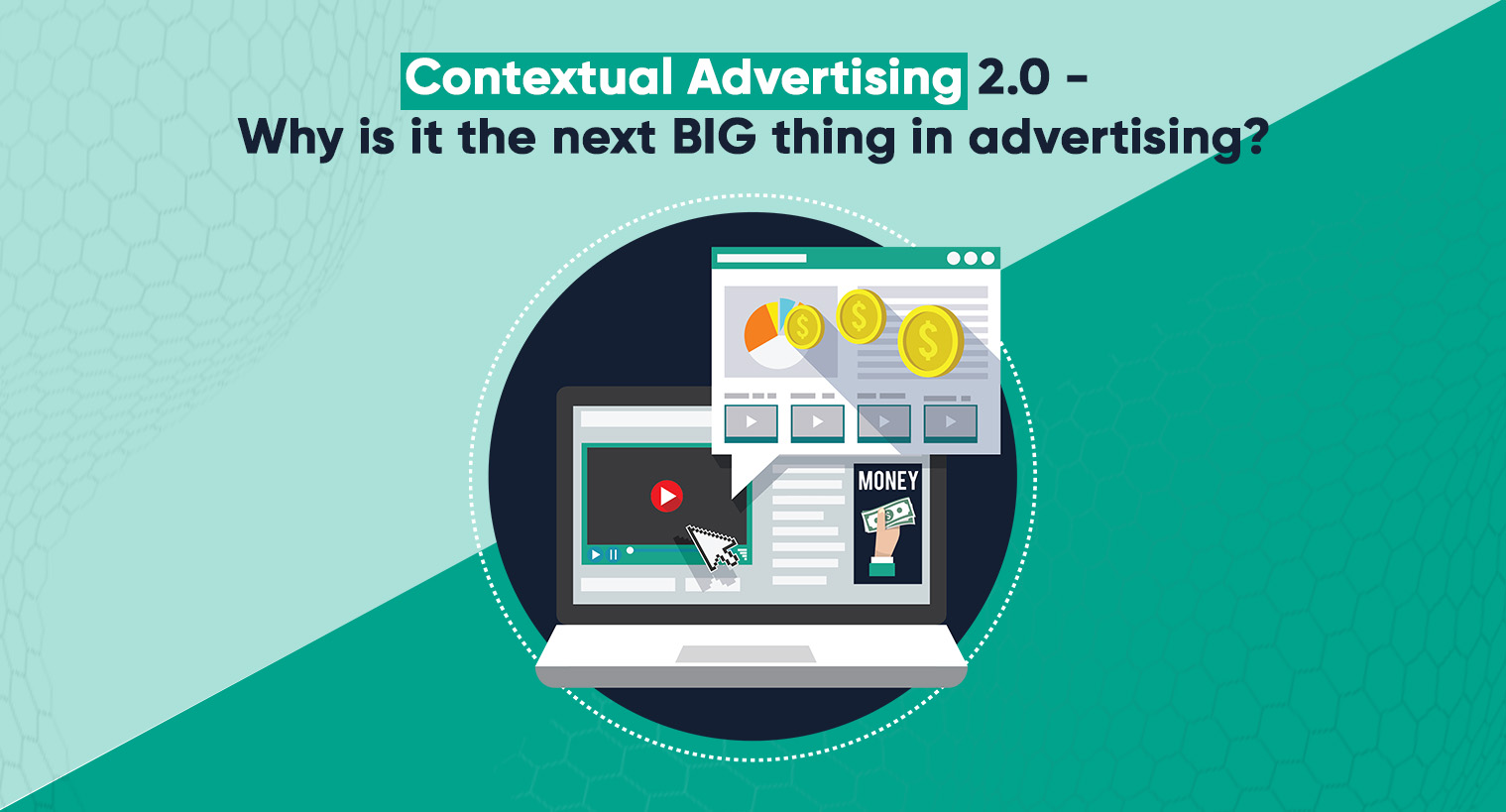
In the rapidly changing landscape, a seismic shift is underway. We are living in times when automation has taken center stage in all sectors, especially advertising.
Gone are the days of laborious manual toil for advertisers and publishers alike. Enter programmatic advertising, the game-changer that harnesses data and technology to plan the perfect sync of ads, reaching their intended audience at the precise moment.
The prediction of global programmatic ad spending is to reach 725 billion by 2026. The United States remains the leading programmatic advertising market worldwide. However, advertisers often encounter, two major challenges with programmatic ads:
- Lack of transparency
- Ineffective targeting
The programmatic advertising environment is intricate and opaque, making it challenging for advertisers to comprehend how the advertisements are deployed. As a result, advertisers waste money on ads and overpay. Programmatic advertising falls short of engaging the target audience since it heavily relies on data.
Also Read: What is Programmatic Advertising?
Navigating Path for Advertisers to Overcome Obstacles
Along with these challenges, there is another elephant in the room, the demise of third-party cookies.
With the third-party cookies phase-out, tracking user data will be difficult as they will not have a unique identifier that can be used to track users across multiple websites.
In this evolving landscape, advertisers find themselves at a crossroads.
- They are in desperate need of a solution that offers them a way to overcome the programmatic ad challenges.
- A solution that targets ads without interfering with the user’s privacy.
As a solution, contextual advertising is a ray of hope.
Contextual Advertising as a Solution: How?
In the dynamic realm of advertising, contextual advertising isn’t a newcomer. This methodology which aligns ads with the surrounding content, lost its spotlight as advertisers pivoted towards behavioral targeting, a strategy yielding superior outcomes by delivering personalized ads.
Yet, the relentless pursuit of personalization led to an overindulgence, raising concerns among users about data misuse and their digital safety.
The privacy concerns of users led to the introduction of strict guidelines by GDPR and CCPA along with major browsers banning the use of third-party cookies.
These changes have made advertisers retrace their steps to an older path of advertising– Contextual Advertising.
Contextual display advertising focuses on aligning the ad with the content of the web page rather than emphasizing the user’s data.
The AI-powered system identifies key contexts of the web page’s content and serves the most relevant advertisement based on contextual cues.
For example, a user engrossed in an article about car maintenance encounters an ad spotlighting the latest automobile release by a prominent brand. Here, the connection is made not through personal data but through content relevance.

Contextual targeting 2.0: Why is it better this time around?
As the world moves forward, contextual advertising is pacing up with it! The recent advancements in algorithms have helped advertisers to perform hyper-contextual targeting.
Natural language processing (NLP) is used to analyze the text content of web pages in order to help advertisers understand the context of the content.
Machine learning is used to develop algorithms that can predict the likelihood of a user clicking on an ad. This can enhance the ROIs and ensure advertisers that they are only paying for ads that are likely to be clicked on.
Hyper-contextual targeting is still in its early stages, but it has the potential to revolutionize the way that advertising is targeted. As AI and ML continue to develop, hyper-contextual targeting is likely to become even more accurate and effective, leading to better results for advertisers and publishers alike.
Get Started with Contextual Advertising Today!
AdTech organizations are taking full leverage of this evolving time! Silverpush, a leading ad tech organization, has introduced Mirrors, an AI solution for programmatic contextual advertising.
Mirrors comprehensively identify key contexts across webpages, including text, images, and videos. Utilizing Natural Language Processing (NLP), it identifies keywords and categorizes content. Additionally, AI-powered technology employs video analysis for image recognition, effectively identifying celebritiy name, brand name, and various activities within images.
Furthermore, Mirrors employs semantic analysis on the content of a webpage. This enables the extraction of significant information, including emotions and instances of sarcastic expression. This extracted information contributes to the deployment of relevant advertisements.
Still not convinced? We have more!
Unlocking Advantages
1. Abides by strict privacy guidelines: According to a study, 72% of Americans are concerned about their privacy.
Contextual advertising abides by the privacy guidelines set by GDPR, COPPA, and CCPA as it doesn’t rely on cookies rather it depends on the content the user is consuming.
2. Drives high Return on Investment and Return on Ad Spend: Contextual programmatic advertising leverages the already generated interest of the user. Since the user is already intrigued by the topic, the chances of the user clicking on relevant ads increase significantly.
3. Relevant to the user: The audience demands relevancy, when tailored ads are shown to the user they feel more comfortable. According to a study, 79% of UK consumers are comfortable seeing contextual ads.
4. Brand safe: While focusing on user privacy advertisers also need to focus on their brand’s safety as well. Brands’ reputations must not be compromised at any cost. Wrong ad placements have often led to a damaged reputation and revenue loss. Since ads are placed based on relevancy, brands can ensure that their ads are placed in brand-safe and suitable environments.
Final Thoughts
Contextual programmatic advertising becomes a sustainable choice for the advertising landscape. As tracking methods like cookies are fading away and brands and advertisers are emphasizing privacy-focused targeting approaches.
Combining contextual programmatic targeting with artificial intelligence and machine learning can provide advertisers with valuable information for effective targeting. This approach offers a wide range of insights to help advertisers reach the right audience and fit seamlessly in the evolving landscape.
Finding Balance: Contextual Advertising and User Privacy in Open Web
PUBLISH DATE: 07 June 2023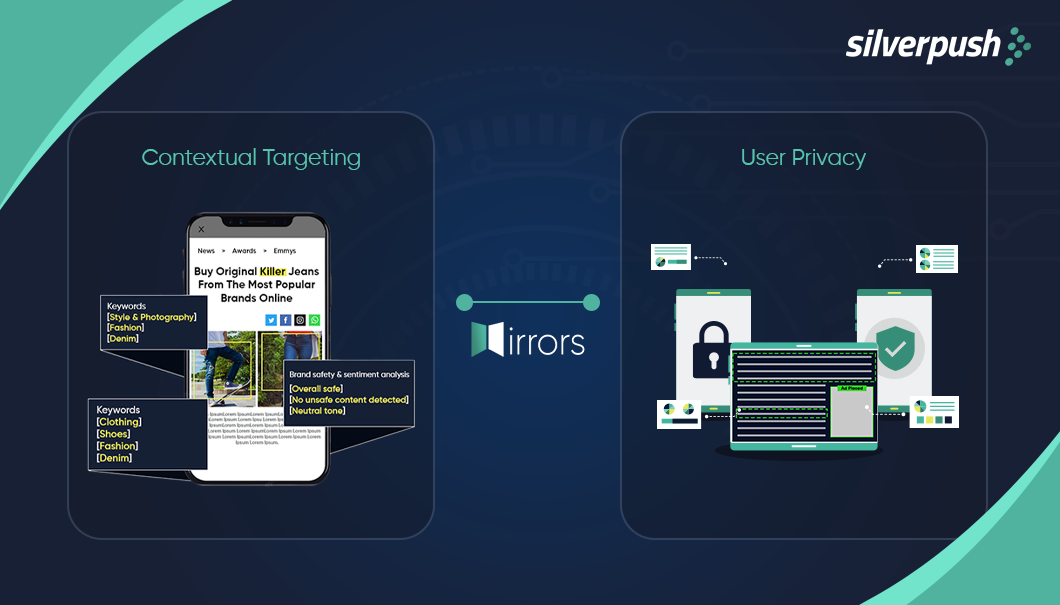
Advertising is a crucial element for any brand as it drives its revenue by pursuing customers from the beginning of the funnel, that is, brand awareness to conversion. Along with customer acquisition, it also generates strong brand awareness and builds a brand image.
The advertising landscape today is facing the issue of users’ online privacy which has become an alarming concern for brands. It is moving towards privacy-first advertising.
“66% of consumers have expressed discomfort with businesses and brands tracking their browsing history to deliver personalized ads.”
This statistic highlights a growing unease among internet users regarding the use of their data for targeted advertising purposes. As a result, businesses and advertisers are increasingly seeking alternative strategies that respect user privacy while still delivering relevant and engaging advertisements. In this context, finding a balance between personalized advertising and privacy has become crucial for brands to maintain consumer trust and loyalty.
Mirrors is a contextual advertising solution for the open web by Silverpush which is helping brands tap into the audience while abiding by the privacy guidelines set by General Data Protection Regulation (GDPR) and California Consumer Privacy Act (CCPA).
How can Mirrors be a Game Changer in a Privacy-First Environment?
More and more internet users worldwide are expressing increased concern about their online privacy, with 67% of the population is stating that they are more concerned than ever. A study found that 81% of people prefer to see ads that are relevant to their browsing experience, and 65% of consumers have a more positive opinion of brands that offer contextually relevant ads.
And, with this, brands need to be more concerned about their advertising strategies to navigate this shift in consumer mindset.
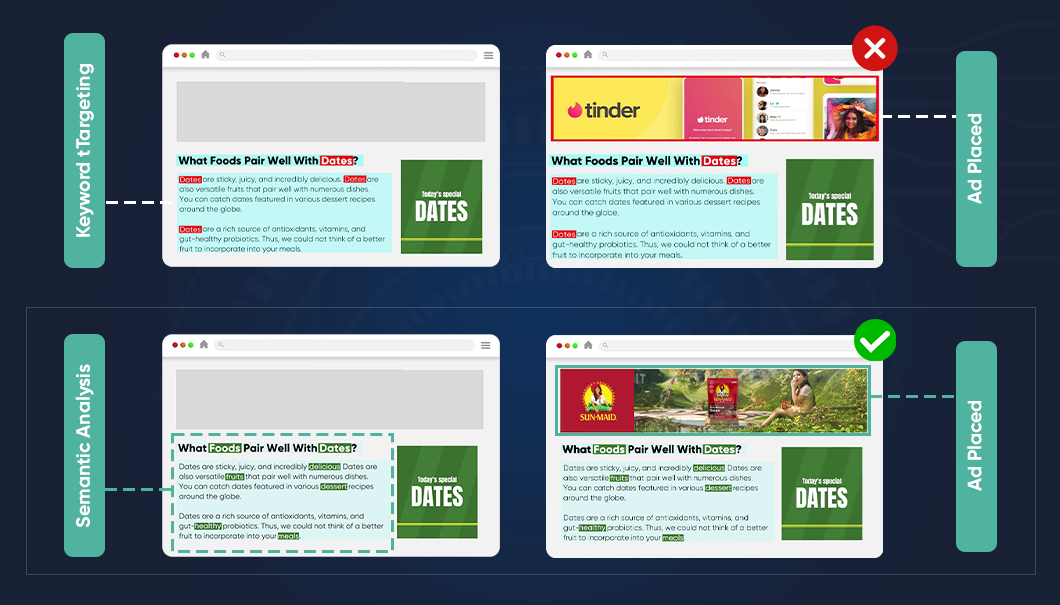
To address these concerns and preferences, contextual advertising has emerged as an effective solution. The AI-powered technology analyzes the content of the webpage and deploys the most relevant ad based on contextual triggers. These triggers include identifying key contexts of the entire content. With this approach, advertisers ensure that the user is targeted with the most relevant ad.
Contextual ad targeting also benefits advertisers by providing a higher number of relevant ads to consumers. Since the ads are displayed based on the content of the page, they are more likely to align with users’ interests and increase engagement.
For example, if a user is looking for the latest laptop, the AI will target the user with the most relevant ad that will be related to the content of the webpage.
Another benefit is that, unlike other targeting methods, contextual advertising doesn’t rely on collecting or storing personal data about users, alleviating privacy concerns. This form of targeting offers a privacy-friendly approach that aligns with users’ increasing concerns about data usage. It delivers relevant ads based on webpage content, enhancing user experience and generating more positive perceptions of brands.
But why has contextual advertising been a widely accepted approach?
Contextual advertising has been a widely accepted approach because in the changing landscape of advertising it aligns the best with the requirements of users and advertisers.
Today, users expect privacy assurance more than a personalized ad experience. They want their identity and information to be safe as they browse the web.
Keeping the rising concerns in mind, major browsers like Firefox, Safari (Apple), and Opera banned third-party cookies from use and Google Chrome began working on the alternative.

Third-party cookies have historically played a significant role in behavioral targeting. Here’s an overview of their role:
1. Collecting User Data: Third-party cookies are small text files that are stored on a user’s browser by a website other than the one they are currently visiting. These cookies allow third-party advertising networks or tracking companies to collect data about a user’s browsing behavior, such as the websites they visit, the pages they view, and the products they are interested in. This data is crucial for behavioral targeting.
2. Profiling and Segmentation: With the help of third-party cookies, advertisers were able to create user profiles and segment audiences based on their browsing habits and interests. By tracking users across multiple websites, third-party cookies gathered a wealth of information that helped advertisers understand individual preferences and tailor their advertising messages accordingly.
3. Personalized Advertisements: Advertisers use the information provided by the third party to serve relevant ads based on a user’s browsing history and interests.
4. Retargeting: Third-party cookies enable retargeting, where ads are shown to users who have previously interacted with a brand or visited a specific website, thereby increasing the chances of conversion.
5. Measurement and Analytics: Advertisers could monitor click-through rates, conversions, and other key performance indicators by leveraging the data stored in these cookies. This information helps advertisers optimize their campaigns, refine their targeting strategies, and make data-driven decisions.
These factors increased concerns about privacy among users which lead to drastic changes in the advertising. Hence, contextual targeting has become a useful alternative to survive in this dynamic advertising landscape.
Conclusion
The advertising landscape will continue to evolve, advertisers must find a solution that caters to the privacy concerns of the user without diverting from personalized messaging. Advertisers are rapidly inclining towards the contextual targeting approach. This is because it is the only and best available option to gain a competitive edge. This approach not only ensures safety but also drives better results and Return on Ad Spend (ROAS).
FMCG Industry Advertising Future: Capitalise the Power of Relevancy
PUBLISH DATE: 26 May 2023
The FMCG industry is a vital component of the global economy, contributing significantly to a country’s Gross Domestic Product (GDP) and job creation. As a major driver of consumer spending, FMCG plays an essential role in various aspects of the economy.
The FMCG market size was evaluated to be 716.3 Billion in 2022 and the CAGR growth rate is expected to be 4.41% from 2023 to 2028.
The market size of the FMCG industry has significantly grown in the U.S., China, and other developed markets. Keeping the growth in mind, the experts are predicting 70% growth on a global scale. The World Bank predicts that in terms of consumer market the FMCG market in India will take the third place surpassing Japan and Germany by 2030.
The consumer industry is a highly competitive landscape, with brands vying for market share based on product type, production techniques, and distribution channels. However, in this fiercely contested arena, advertising is the key to success for them. But the advertisers are facing a set of challenges in the advertising landscape.

What are the Advertising Challenges Faced by the FMCG Industry?
According to a study, till 2023, FMCG firms were expected to raise their digital advertising spending by 7% yearly. FMCG expenditure decreased by 10.7% to $ 26.7 billion in 2020, a more significant decrease than the whole advertising industry.
But utilizing the ad spend is a bigger and more important factor. Since the FMCG industry is flooded with brands and products, getting brand visibility and brand recognition are the two main purposes of advertising for them. To achieve both goals choosing an appropriate advertising approach is crucial. But due to a shift in consumer behavior creating a positive and solid brand image has become difficult.
The consumer has become more empowered and they want to control everything they see, especially in the virtual space. They want to see the ads of their interest but without getting digitally stalked. 72% of people believe that virtually all of what they do online is being monitored by advertising, technology corporations, or other businesses, and 81% believe that the threats can surpass the possible rewards of data collecting.
Not only the audience but the traditional advertising ways have often led brands to face consequences of negative branding due to wrong ad placement. This not only damaged their reputation but also resulted in ad wastage.
The Rise of Contextual Advertising
Have you ever noticed that whenever you walk into a supermarket to get one item from the shelf you end up filling the cart? This is because at that moment you were interested in the items, they were relevant and you were triggered to buy them.
Contextual advertising is similar!
Through contextual targeting, advertisers reach the target audience at the right moment which triggers them to engage with the brand. According to a study, 79% of respondents agreed that they were comfortable with the ads that are relevant to them. Also, 65% said they would be more tempted to buy from relevant ads.
How can the FMCG Industry Benefit from Contextual Ads?
One approach to take advantage of the opportunity is through omnichannel contextual advertising. Silverpush’s remarkable AI-powered solution, Mirrors, ensures brand safety and suitability across various advertising channels. The high-powered AI technology ensures the message reaches the right audience.
1. YouTube
For the FMCG industry, video advertising is the most suitable ad format. YouTube offers various ad formats and advertisers can choose the most suitable format for them. According to a study, 88% of video marketers were satisfied with the ROI of their video marketing on social media.
In the past, an FMCG brand chose 1 video creative to connect and interact with the target audience. The campaign has delivered more than 9 million impressions in 28 days.
Post-campaign analysis the brand concluded that they had reached more than 5 million unique users. The campaign performed beyond the industry benchmarks as it surpassed the planned KPIs (VTR).
2. Open Web
Relevant advertising can be shown depending on the webpage content that the target audience has viewed. The mirror captures the audience’s attention, without invading the user’s privacy. This gives users a sense of safety and the advanced AI-powered technology ensures that the ad is placed in a brand-safe environment.
3. Meta
To extract contextual signals that enable the distribution of real-time, in-the-moment advertising for outstanding results, Mirrors carefully selects and examines brand-safe Facebook pages. Models for Artificial Intelligence (AI), Machine Learning (ML), and Natural Language Processing (NLP) are used to do this.
4. CTV
On most streaming TV services, CTV represents over 80% of all viewing. The remaining 20% is accounted for the other devices connected to the internet (laptops, smartphones, and tablets).
As per studies, ad spending on linear and connected TV (CTV) combined will increase from $87.24 billion to more than $100 billion in 2026. This will be due to the surge in CTV viewing.
When marketers purchase advertising space on CTV, their commercials are played to viewers when they stream movies, TV series, and other content to their linked television. To ensure brand safety, ads are delivered in the proper context with the help of semantic analysis, content analysis, and customized ad segments.
Takeaways
The advertising arena is changing rapidly and for the FMCG industry, it is their primary source of establishing brand recall. Contextual advertising can be a game-changer for them as it will help them in capitalizing on the interest of the user. It will help drive engagement without intervening with the privacy of the user. Also, omnichannel advertising can play a significant role in strengthening brand recognition.
Discover How to Capture Hearts With Pride Advertising
PUBLISH DATE: 15 May 2023
Pride month is in full swing, with the month of June on its way. The LGBTQ community globally accounts for 4.6 trillion US dollars. The community has been in the news globally, as many countries recognize them and are helping them live free lives.
Pride Month is celebrated in honor of individuals who were involved in the Stonewall Riots of 1969. With the glitter and rainbow flags, people join the festivities. whereas, by changing colors, sharing Pride Month trivia, and social media posts advertisers tap into every opportunity for Pride Month advertising.
How Brands Leveraged Pride Month Before?
Pride advertising is another example of moment advertising which brings huge reach for brands and a chance to make a long-lasting impression. Burger King and Honey Maid are the two brands that made the most out of the Pride Month advertising in 2014.
1. Proud Whopper

In 2014, Burger King ran the ” Be Your Own Way” campaign under which it launched “Proud Whopper”. It was a spin on its “Have It Your Way” brand positioning.
During the pride parade, it launched its Whooper burger, which came in rainbow-colored wrappers. What intrigued the audience with this burger was the strong message that resonated with them. It said, “We are all the same inside”.
The campaign stood out as it received 7 million views across all social media channels. There were more than 5.3 million views on the YouTube video alone. 20% of Americans saw the Proud Whopper advertisement, and young millennials over-indexed by 4.8X.
2. This is Wholesome
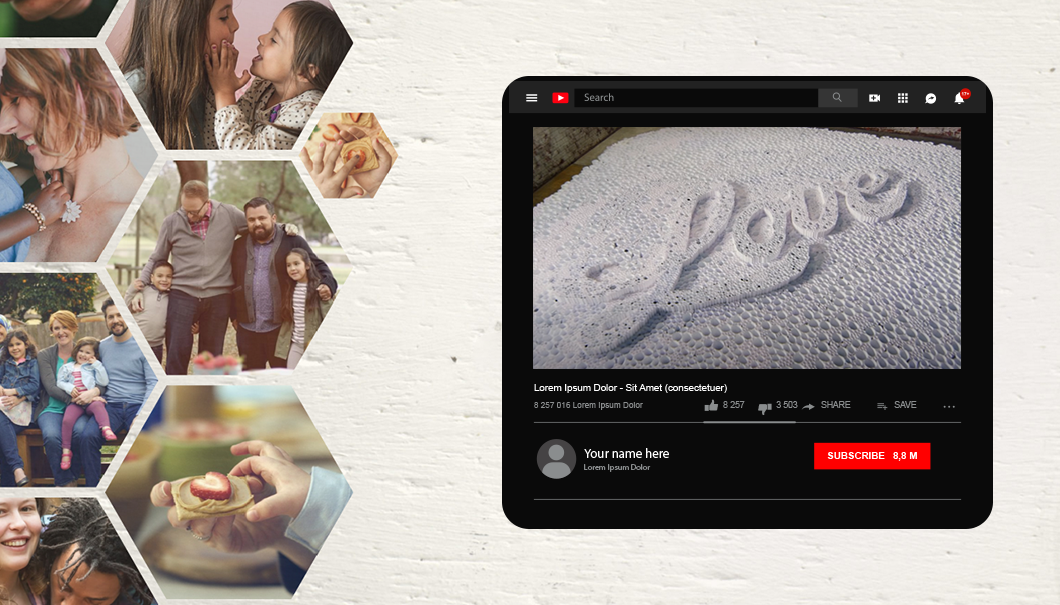
Honey Maid recognized a chance to engage with its consumers while highlighting its long history and commitment to inclusivity by honoring the variety of the contemporary family.
Over 8 million people had seen the 30-second ad on YouTube. According to YouTube statistics, Honey Maid was able to determine that 97% of the ad’s video views came from those aged 25 to 54 using age and gender targeting. Women help the majority in viewership as they account for 98% of the total.
However, there was an obstacle that arose during the campaign. The message of the campaign did not resonate with everyone which led to negative tweets and comments.
Honey Maid saw it as an opportunity to tap into the audience’s mind and capitalize on it. They created a clever response to the negativity. They made a video ad, where two artists utilized printouts of all the critical comments to form the word “LOVE”.
It was straightforward and effective, giving Honey Maid another opportunity to demonstrate its dedication to the causes of diversity and equality as well as its support for the LGBTQ community.
More than 4 million people viewed “Love.” According to YouTube data, the first 90 days of views were equally split between males and women, and over a quarter of viewers were millennials under the age of 24.
What are the Key Takeaways?
Both campaigns significantly benefited the brand by building strong brand awareness. But another key takeaway that advertisers had was the importance of a message to resonate with the audience. Engaging the audience emotionally is a simple yet strong way to make a place in people’s hearts.
How to Make the Most from Pride Advertising In 2024?

The advertising landscape has transformed a lot. A privacy-focused future has made Apple and Firefox take the revolutionary step by banning the use of third-party cookies whereas Google is planning a strategic phase-out while working on alternatives.
So, how can brands make the most during the pride month?
Contextual Advertising is one of the ways to capitalize on the opportunity. Mirrors is a revolutionary AI-powered technology offered by Silverpush that ensures advanced brand safety.
The high-powered AI technology ensures that the message reaches the right audience at the right time. Mirrors identify key contexts of the blog by analysing content and classify into segments.
This year, advertisers can make the most of Pride Month by relying on omnichannel contextual advertising as Mirrors can function across multiple channels.
1. YouTube
Video ads are widely acceptable, and they accounted for 82% of global internet traffic in 2022. The context detectors help Mirrors find the relevant ads. This increases the possibility of users engaging with the brands as they are relevant to the user when they are highly intrigued.
2. Open Web
Based on the content of the webpage consumed by the target audience, AI-based technology can place relevant ads.
3. Meta
Mirrors carefully chooses and analyzes brand-safe Facebook pages to extract contextual signals that enable the distribution of real-time, in-the-moment advertising with remarkable performance. This is done with the help of Artificial Intelligence (AI), Machine Learning (ML), and Natural Language Processing (NLP) models.
4. CTV
Pride ads are displayed in appropriate surroundings using semantic analysis, content analysis, and customized ad segments to prevent inappropriate placement depending on user emotions and behavior. Facebook is the best place for people with varied interests.
Conclusion
Advertising for Pride is more than simply recognizing and appreciating the LGBTQ community. It is the opportunity for brands to communicate their truth and take a position. According to a study, 45% of consumers under 34 years old say they’re more likely to do repeat business with an LGBTQ-friendly company. It is time for brands to take this opportunity to attract their desired audience contextually.
Cricket and Advertising: Winning Strategies for the 2023 World Cup
PUBLISH DATE: 12 May 2023
Cricket is Life. Everything else is just a game.
With 2.5 billion estimated followers, cricket is the second most popular sport around the world. The upcoming 2023, ICC Men’s Cricket World Cup has already generated excitement among fans.
The ICC Men’s Cricket World Cup isn’t a tournament that viewers enjoy; rather, it is a festival for brands to establish a rock-solid awareness. Brands have a cut-throat competition to grab the attention of the dedicated audience.
In 2019, 94% of the sports AdEx was from cricket, highlighting the popularity of the sport among advertisers. The online streaming of the matches brought a new advertising field when the World Cup was first streamed on an OTT platform in 2015. Indian advertisers alone were expected to spend more than 400 million, and Star India expected TV and internet revenues to be around Rs 2,100 crores. Along with e-commerce, gaming, soft aerated drinks category, cellular phones, wires & cables, and perfumes & deodorants were some popular categories that were on top of TV advertising. Brands paid 20 lakhs onwards for 10-second ad spots, and the sponsorship package was for 40 crores onwards.
How Brands Can Capitalize 2023 Cricket World Cup Opportunity?
The 13th 50-over ICC Men’s Cricket World Cup will take place in 2023, with India serving as the host nation. The quadrennial tournament is scheduled to take place in 2023, with India serving as the host nation for a record-breaking fourth time.
The format of the tournament will be round-robin before the knockout rounds, like the 2019 competition in England and Wales.
World Cup is the best time to tap into the audience’s mind and create a brand’s presence. Advertisers can use omnichannel advertising strategies to engage with the audience across all platforms and channels during the World Cup.
Some ways to capitalize are:
Traditional Methods Include
1. Sponsorship – Brands can become official sponsors of the tournament. A recurring brand recall can be easily created as brands will be promoted alongside the event branding.
2. Television Advertising – There is a drop in this field of advertising but millions of people are still glued to tv screens when there is a match, especially in remote areas. By creating strong tv ads brands can have the ever-lasting memory for the audience.
The “Mauka Mauka” ad campaign created a huge brand recall in 2015 and 2019 irrespective of the results. The notable point is when the first advertisement appeared on YouTube in 2015. it received more than a million organic views in the first 12 hours of being live.
Digital Methods Include
1. Video Advertising: People eagerly wait to grab any information during a cricket match. From watching a live cricket match on the OTT platform to watching highlights on YouTube, videos get the center of attention. Advertisers can leverage this attention by using different ad formats available on YouTube.
2. Social Media Advertising: During cricket tournaments, social media platforms, Instagram, Facebook, Twitter, and LinkedIn are flooded with updates. These platforms offer various advertising opportunities which an advertiser can utilize to benefit themselves. Based on the demographics, advertisers can target specific audiences.
3. CTV Advertising: A huge set of audience is shifting from traditional TV streaming to connected devices. This is an advantage for advertisers as CTV allows granular targeting. This means with the right message, advertisers can reach their target audience exactly where they are.
Another interesting advertising element present for the 2023 World Cup is contextual targeting. In 2019, the news of the phase-out of third-party cookies was spread. This led advertisers to look for an alternative. But during 2019, contextual advertising was not in the picture. However, with time this form of advertising proved to be a beneficial alternative. Combining the power of contextual advertising and the World Cup together can bring outstanding results.
Mirrors is a flagship product of Silverpush which is helping brands reach their target audience on different channels in the most contextual way possible.
How Brands Can Leverage the AI-Powered Technology, Mirrors?
Studies have proven that 63% of users prefer relevant ads and it makes them engage with the brand. This also results in higher ROIs and ROAS.
With contextual advertising, advertisers can easily engage the audience on each platform without interrupting their viewing experience.
Mirrors for YouTube
People are glued to the screen when it’s time for the World Cup. Men’s CWC 2019 live coverage crossed a cumulative average audience of 1.6 billion viewers on a global scale. The average watched time per unique viewer was 42% higher than in 2015. This leaves advertisers with the hope that it will be much higher for 2023.
To leverage the attention of the large audience of human-augmented technology, Mirrors is trained to place ads in the most relevant manner. With the help of the AI will recognize the triggers and will place the most suitable ad that aligns with the content consumed by the user.
Mirrors for Facebook
Mirrors similarly work for Facebook. But while extracting insights based on visual triggers it also dives into the context of the text.
Keyword-based targeting reduces the reach of a campaign by blocking the content based on keywords, contextual targeting understands the context of the word being used. This enhances brand safety as well as increases the ad placement opportunity.
Final Words
The World Cup is a complete package for advertisers to promote. Brands have a fantastic chance to expand their awareness and connect with a global audience during the World Cup. With the popularity of cricket at an all-time high, advertisers must take advantage of this trend and develop effective marketing campaigns that connect with their target market.
We can claim that brands could expect improved ROIs and reach during the 2023 ICC Men’s Cricket World Cup by harnessing the power of contextual advertising.
Play Safely: Strategies for Brand Safety in In-Game Advertising
PUBLISH DATE: 30 April 2023
Video games have always engaged a large audience, especially GenZ, and millennials. This gives advertisers and brands an opportunity to innovatively establish a solid brand recall.
As gaming devices continue to gain popularity and offer more opportunities for brands to reach their audience, the global gaming market is predicted to grow at a CAGR of 9.9% from 229.39 billion in 2022 to 252.10 billion in 2023. Additionally, it’s projected to reach 401.32 billion by 2027 at a CAGR of 12.3%.
The gaming industry is in an evolving phase and advertisers must explore this in-video game advertising. The primary reasons are:
- The gaming industry has a huge audience base who play games on different devices. This means brands have more than one opportunity to reach their targeted audience.
- With a large audience reach, the gaming industry has a loyal fan base. According to a study, in-gaming advertisements had influenced 44% of gamers to engage with brands.
However, this pool of advertising opportunities will require brands to focus more on brand safety.
What are the Key Components of Brand Safety for In-Video Gaming Advertising?
Measures taken to protect the brand image are known as brand safety. This is done to protect brands from irreparable damage as we had a few examples in the past of how the brand’s reputation was damaged beyond repair due to ad placement next to inappropriate content.
Interactive Advertising Bureau (IAB) has shared an impactful framework for advertisers which can help them in ensuring brand safety.

1. Contextual Targeting:
The process to phase out third-party cookies was started years ago. This was done to abide by the privacy of the user. Amidst the evolving landscape of advertising, advertisers began to rely on contextual targeting which resulted in higher brand engagement. In-video gaming advertising, advertisers must rely on contextual advertising to be profitable as the AI-powered technology ensures that the ads appear to the relevant content. A customized blocklist is prepared but unlike keyword-based targeting, the AI understands the context of the keywords used like a human mind. This increases the advertising opportunity, brand safety, and audience engagement with the brand.
2. Partner Selection:
Brands look for partners who would help them in setting up the ads in the video games. But before finalizing the partners, brands must evaluate them based on their game quality, advertising ecosystem, and compliance with General Data Protection Regulation(GDPR) and Children’s Online Privacy Protection Act (COPPA) regulations. It’s also essential to review the game’s content for any violent or inappropriate content that doesn’t align with the brand’s values. Advertisers should request a comprehensive explanation of the partner’s brand safety policies and a block list of prohibited advertisers or services.
To enhance your brand safety, you perform the following steps to ensure multi-level verification. Use a combination of the following verification tools:
- Viewability – This will help you get the percentage of ads seen by your audience. This tool ensures that your ad is seen by the target audience.
- Fraud detection-This tool will help you in identifying and preventing fraud. It will detect invalid traffic, bots, and any fraudulent activity which has the ability to impact your campaigns.
- Brand Safety Protection- This tool will add an additional layer of protection for contextual targeting. The tool will ensure that your ads aren’t displayed against inappropriate content.
- Audience Verification- This tool will give you insights into the audience who have seen your ad.
3. Ad Placement and Monitoring:
A key component of brand safety in video game advertising is ad placement. To prevent any unfavorable connotations with the brand, advertisers should make sure that their adverts are positioned in the proper areas inside the gaming environment.
For instance, advertisements for gambling or alcohol shouldn’t be included in kid-targeted games since they might expose kids to unsuitable content and harm the reputation of the company.
In a similar vein, advertisements for graphic or explicit content need to be kept out of games targeted only at adults. To make sure that their advertising is neither obtrusive nor disruptive, advertisers should also take the context of the gaming environment and the entire user experience into account.
Apart from the placement advertisers should keep a close eye on their campaigns to ensure they are not running in inappropriate places. Utilizing technology solutions and collaborating with partners to resolve any problems that may occur be part of this. For instance, advertisers may check ad placement and look for any possible brand safety issues using third-party technologies. They may also closely collaborate with their partners to resolve any problems and make any necessary modifications. In order to track success and pinpoint any areas for improvement, advertisers should also set up clear reporting tools. Advertisers that regularly report on their campaigns can better spot potential problems and take proactive steps to solve them before they become a problem.
Conclusion
The gaming industry is on the rise and in the coming years gamers will be a prominent and much larger community. Advertisers must explore this evolving landscape of advertising while they focus on brand safety.
How Contextual Advertising is Driving Sales in the Automotive Industry
PUBLISH DATE: 11 April 2023
Challenging. It is the correct word to describe how brands consider advertising in the automotive sector.
This is mostly due to the long purchasing cycle by consumers involving a large chunk of money coming out of their pockets.
Despite the challenges, automotive brands cannot afford to miss out on the immense consumer spending in this industry. In fact, the automotive industry is one of the largest spenders on advertising worldwide. According to a report by Statista, in 2020, the automotive industry in the United States alone spent a whopping 12.42 billion U.S. dollars on digital advertising.
Contextual advertising can be a highly effective strategy for automotive brands to reach their targeted audience in the right place, at the right time, and with the right message. This approach allows advertisers to target potential customers based on their interests, online behaviors, and purchase intent, without using their personal data.
What’s Unique About the Automotive Advertising Industry?
Before delving into automotive advertising strategies, it’s crucial to understand the unique nature of this industry.
Vehicles are a significant financial investment, and consumers often spend a considerable amount of time in the consideration phase. In fact, car buyers spend an average of almost 14 hours online during their research and visit around 4.2 websites before making a purchase decision.
As the buying journey almost always starts online, reaching potential customers with a programmatic campaign is essential long before they step foot in a car dealership.
Brands who want to reach their target audience need to first understand them. The target audience can vary depending on the type of vehicle being advertised. For instance, ads for luxury cars are targeted toward individuals with higher incomes, while family-friendly car ads are often aimed at individuals with lower to middle incomes who have families and need practical transportation options.
Also, the customer journey is an entirely complex process where customers rely on different platforms to get information about the car they are looking for.
For instance, a person interested in buying a car may watch advertisements for cars on Connected TV (CTV) using their mobile or desktop devices. To learn more about a specific car, they may browse online through OpenWeb to gather information about the car’s engine, features, and other details.
Additionally, they may ask for recommendations or advice from their friends on social media platforms like Meta to gain insights from other people’s experiences. By using multiple devices and platforms, the person can make a more informed decision when choosing a car that suits their needs and preferences.
This is where advertisers can leverage the situation to reach their target audiences at the right time and place when those audiences are most likely to be receptive to their ads and engage with them.
Contextual advertising is a powerful tool in the automotive industry, as it enables brands to understand the context of a webpage and tailor their advertising message accordingly. This can capture the customer’s attention at the right moment and potentially influence their purchasing decision. By leveraging contextual data and creating relevant and engaging ads, brands can make an impact and connect with potential customers in a competitive and challenging industry.
Maximizing Advertising Relevance with Mirrors’ Hyper Contextual Advertising
Silverpush’s flagship product – Mirrors is an AI-powered hyper-contextual technology that watches and listens (word-by-word), allowing you to target audiences with both precision and scale-ultimately driving better brand outcomes.
It ensures that your messaging reaches your users, during key decision-making moments which further amplifies the message and taps into users’ current state of mind. Thus, driving higher performance and efficiency for some of the largest auto brands in the world.
One of our major auto brands benefited greatly from our next-gen hyper-granular context targeting powered by AI to leverage what auto consumers are watching on YouTube and drive trust and personal connection with a captive audience.
Plan an Omnichannel Marketing Strategy with Mirrors
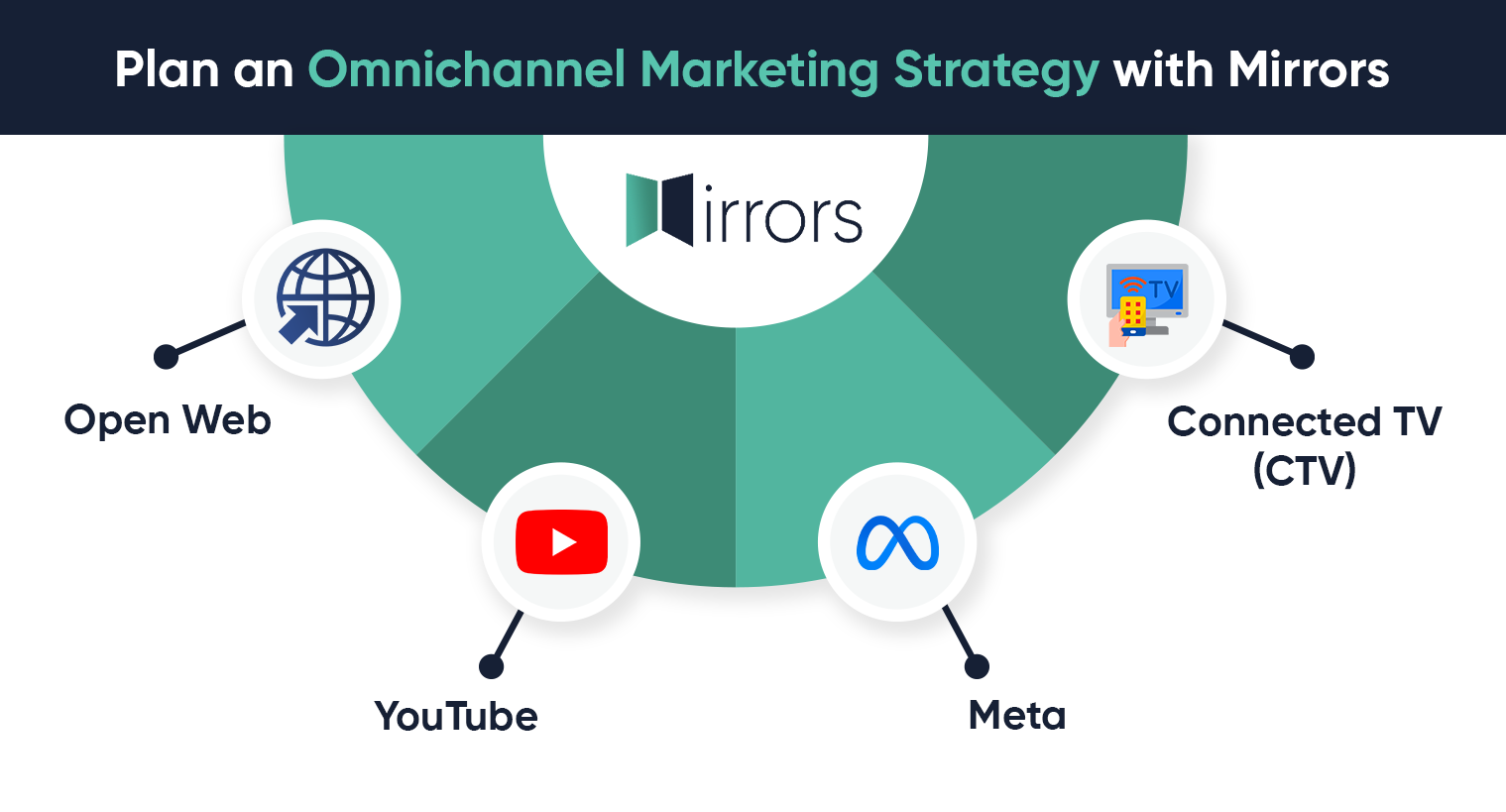
Mirrors, the next-generation AI technology, offers brands a multi-platform solution to advertise across various channels, thereby extending their reach and amplifying their marketing efforts.
1. Open Web
Targeting audiences based on website content. Mirrors can also display ads based on the content of the user’s website. For example, if a user is reading an article about eco-friendly cars, contextual advertising can display ads for hybrid or electric cars.
2. YouTube
~ 90% of global shoppers surveyed say they discovered new brands or products on YouTube and 40% say they have purchased products they discovered on YouTube. Watch time of car videos on YouTube has grown by more than 65% in the past two years. When looking to buy a new car, consumers often turn to video research. Auto marketers can use this opportunity to reach potential buyers who are actively considering a purchase, even if they are not familiar with their product. Over 75% of auto shoppers say that online video has influenced their shopping habits and purchases.
3. Meta
By leveraging Artificial Intelligence (AI), Machine Learning (ML), and Natural Language Processing (NLP) models, Mirrors carefully selects and processes brand-safe Facebook pages to extract contextual signals that enable the delivery of real-time, in-the-moment ads with exceptional performance. This advanced technology empowers brands to serve highly relevant ads while ensuring brand safety on Facebook.
4. Connected TV (CTV)
Mirrors analyzes content, creates custom ad segments, and uses semantic analysis to display ads in premium and relevant CTV video inventory, avoiding misplacement based on user emotions and behavior.
Exploring Real-World Use Cases of Mirrors
1. How Mirrors Helped an Automotive Brand in Competitor Conquesting
An automotive car brand leveraged Mirrors’ AI technology to identify cues related to key features of its competitors’ vehicles across different segments. With this information, the brand effectively targeted YouTube content containing these cues and seamlessly insert their brand messaging. By utilizing Mirrors, the automotive car brand efficiently and strategically reach its target audience while also gaining a competitive edge over its rivals.
2. Mirrors Enabled an Automotive Brand to Achieve Complete Brand Safety in Ad Display
Our client, an automotive car brand successfully utilized Mirrors to maintain brand safety while advertising on digital platforms.
Mirrors’ pre-defined visual and audio context identification allowed us to exclude videos that did not align with our core values. By conducting analysis, our AI became even more selective about when and where to block content, thus ensuring the perfect balance between brand protection and suitability.
Our brand safety standards, fully aligned with industry standards such as GARM, COPPA, CCPA, GDPR, and LDA compliance, were enhanced without over-blocking. Thanks to Mirrors, the automotive car brand effectively maintained brand safety while simultaneously maximizing our reach and engagement with our target audience on YouTube.
3. Automotive Brand Utilizes Analysis for Contextual Ad Placement
Mirrors helped an automotive brand reach and engage with its target audience interested in automobiles. By leveraging their competitors’ brands through trigger identification based on brands (of Hyundai, Chevrolet, Nissan, etc.), brand ambassadors, influencers, car-tech reviews, automobile showrooms, test drive videos, and more, Mirrors maximized the brand’s exposure in the market.
Through Mirrors’ advanced AI technology, the visual triggers were analyzed and ads were at the right place and moment, effectively targeting the relevant audience.
How Can Brands Benefit from Mirrors’ Hyper Contextual Advertising Technology?

Get Started With An Omni-Channel Marketing Strategy for Your Automotive Advertising
The greatest challenge for marketers in the auto industry is driving users through the often lengthy path to purchase. Since people today are online on a variety of devices, and using a variety of channels, it’s crucial to have coverage across multiple digital environments.
Multi-channel targeting enables advertisers to reach users across different platforms and channels. This helps a campaign achieve greater reach by capturing users wherever they are online.
Ready to drive auto advertising performance? Fill out the form on your right and your Silverpush representative will contact you soon with more information on how to get started.
Unlocking the Power of First-Party and Zero-Party Data: Future of Privacy-Focused Advertising
PUBLISH DATE: 30 March 2023
In 2023 expected data collection from the first-party and zero-party is 118 zettabytes.
Data is the backbone of modern marketing, providing brands with valuable insights into consumer behavior and enabling them to craft targeted campaigns that resonate with their audience.
However, the landscape is rapidly changing, with evolving privacy policies making it increasingly challenging to collect and utilize data in a manner that respects user privacy.
This new reality has given rise to contextual advertising, which offers a less invasive approach and is better aligned with evolving consumer preferences.
Also, inclining advertisers toward the first-party and zero-party data. By leveraging first-party and zero-party data, brands can still gain a deep understanding of their audience and create campaigns that deliver better results while abiding by the user’s privacy.
It’s interesting to note that contextual advertising is expected to witness significant growth in the coming years, with worldwide ad spending projected to reach 228 billion US dollars by 2023. One of the main drivers behind this growth is Google’s plan to phase out third-party cookies, which have traditionally been the cornerstone of behavioral targeting.
While third-party cookies have been an effective tool for advertisers to target consumers based on their browsing behavior, there has been growing concern over user privacy and data protection. As a result, privacy-focused browsers like Firefox and Safari have already blocked third-party cookies over a decade ago.
Explore the Alternatives for Third-Party Data Targeting

The advertising industry has entered an experimental era. Marketers use the hit-and-trial advertising approach. They have incorporated contextual advertising into their behavioral targeting and have begun to favor first-party and zero-party data.
But what are Zero and First-Party Data?
When information is shared with the intention and acknowledgment of the user it is zero-party data. This type of data includes customer preferences, interests, and opinions. Zero-Party Data can be collected in the following ways.
1. Surveys and Questionnaire: Brands ask questions or perform a survey to know the interests and opinions of the audience. For example, Nike surveyed to know which is the audience’s favorite shoe type among Air Force, Air Max, and Air Yeezy. This survey will give a fair idea about the audience’s interest in their product and with further analysis, Nike can target specific shoe ads to the specific user demographic.
2. Interactive Experiences: Companies can offer interactive experiences, such as quizzes or polls, that require customers to provide information about themselves. This can be a fun and engaging way for customers to share information with a company.
3. Contests and Giveaways: This way brands can easily promote themselves and collect the user’s data. For example, An FMCG brand posted a giveaway on Instagram where the user had to enter their details and tag 3 more people in the comment section. Through comments, the brand could get a large audience base and details of some users. Zero-party data is valuable because customers provide it voluntarily when they want to engage with a company.
According to 85% of marketing company respondents, zero-party data is essential for delivering effective tailored experiences. First-party data is passively collected by the brands. This data can include customer names, email addresses, purchase history, and website browsing behavior. The different methods through which first-party data can be collected is:
1. Website Analytics: Companies can use tools like Google Analytics to track website visitors and their behavior on the site, such as what pages they visit, how long they stay on each page, and whether they make a purchase.
2. Customer Relationship Management (CRM) Systems: Companies can collect information about their customers, such as their contact information, purchase history, and preferences, through their CRM systems.
3. Loyalty Programs: Companies can collect data on their customers through loyalty programs, which can track purchase behavior and offer personalized recommendations and promotions. First-party data is valuable because it helps companies understand their customers and provide more personalized marketing and customer experiences.
What’s the Key Difference Between First-Party and Zero-Party?
The key difference between first-party and zero-party data is the method of data collection. The method of data collection impacts user engagement and accuracy.
1. User Engagement: User engagement is much higher with the brand in zero-party because the consumer is directly engaged and has been sharing their information with consent. On the other hand, first-party data is passively collected. The data collected is based on the user’s interaction with the brand.
2. Accuracy: First-party data will involve analytical tools, to get precise information. The data is collected on behavioral targeting strategy which implies the use of analysis at the end. Whereas, the data provided by the user will be correct because the user wants to engage with the brand and wishes to avail the value provided by them in exchange for their information.
Conclusion
Overall, both types of data are valuable for companies as they allow for better understanding and targeting of customers. However, zero-party data is more likely to result in high-quality, personalized customer experiences as it is based on direct input from customers themselves. Another reason that would lead to the rise of zero-party data would be the consent of the user. Every day people are becoming conscious of their information which has already led to the phase-out of third-party data. Since the information gathered will be with the consent of the user, the privacy issues would be eradicated.




